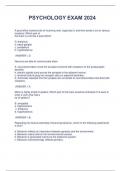Samenvatting
Summary BRM I lectures 4 & 5
- Instelling
- Vrije Universiteit Amsterdam (VU)
- Boek
- Marketing Research
This document includes lectures and some extra elaboration on the SPSS output, since the output interpretation is very important for the final exam. The summaries include examples to understand the concepts more easily. The lectures included in this document focus on Factor Analysis & Sampling
[Meer zien]














